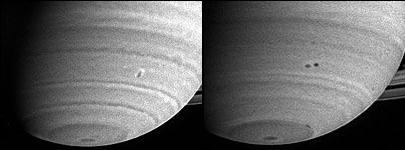Avi Blizovsky

Right: Before: The storms come at different speeds. Left after: merging into one storm
Direct link to this page: https://www.hayadan.org.il/saturn120404.html
The American-European spacecraft Cassini photographed two giant swirling storms on Saturn just as they were merging. This is only the second time such a phenomenon has been observed. Cassini is approaching Saturn to begin a 4-year mission of research in orbit around the planet.
Scientists have been watching Saturn for a month using Cassini when suddenly two storms with a diameter of 1,000 kilometers each approached on a collision course. The storms 'danced' around each other counterclockwise and merged during the days of March 19 and 20. The last time this phenomenon was observed was in August 1981 when Voyager photographed partially merging storms.
Cassini will enter orbit around Saturn when it reaches it on July 1, 2004. When it arrives, it will release the Huygens hitchhiker and six months later, Huygens will plummet through Titan's dense atmosphere.
Both storms in Saturn's southern hemisphere were observed moving west relative to the rotation speed of the planet's interior between February 22 and March 22. According to the calculations, the speed of the more northern storm was 11 meters per second, almost twice the speed of the more southern storm. When they merged they rotated around each other counterclockwise, exactly the opposite of the way hurricanes rotate in the southern hemisphere of the Earth. "These are long-term storms and they seem to 'eat' each other and grow," said Dr. Carolyn Porco, director of Cassini's imaging team. "I don't know how rare this phenomenon is, but it was very challenging to photograph them."
The merger created a huge storm whose shape is elongated in the north-south direction and whose ends are bright. On March 22, the merged storm's shape became more circular and the lighter clouds spread around the circle as a halo. Although these storms traveled west, the storms at Saturn's equator move west at a speed of 450 meters per second - 10 times the speed of Earth's jet streams.
The data collected by the Cassini spacecraft will clearly enrich our knowledge of Saturn's internal forces, which are currently very poorly understood.
"Many storms on the giant planets end their lives by merging. How they form is still unknown, said Prof. Andrew Ingersoll of the California Institute of Technology in Pasadena and a member of the Cassini imaging team.
On Earth, storms survive for about a week and usually dissipate when they move into the mature stage and no longer gain strength from their surroundings. On Saturn and the other large planets, storms persist for months, years, or even centuries.
The Cassini-Huygens mission is a collaboration between NASA, the European Space Agency and the Italian Space Agency.
For news at the BBC
Yedan Saturn
https://www.hayadan.org.il/BuildaGate4/general2/data_card.php?Cat=~~~815333107~~~20&SiteName=hayadan
